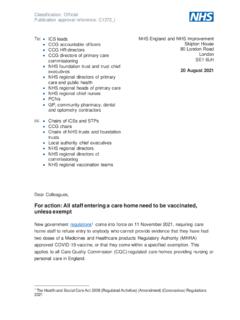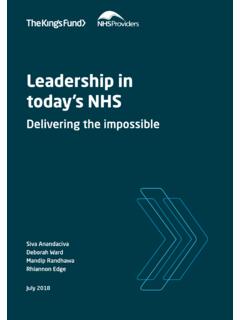Transcription of The learning disability improvement standards for NHS trusts
1 The learning disability improvement standards for NHS trusts June 2018 As part of developing these improvement standards , NHS improvement identified some services that provide care to people with learning disabilities, autism or both, and others that provide care only to those with learning disabilities. We use the term people with learning disabilities, autism or both in these standards , but advise discretionary interpretation of the term to compliment the particular service against which the standards are being applied. We support providers to give patients safe, high quality, compassionate care within local health systems that are financially sustainable.
2 1 | Contents Contents Introduction .. 2 Standard 1: Respecting and protecting rights .. 6 Standard 2: Inclusion and engagement .. 9 Standard 3: Workforce .. 12 Standard 4: Specialist learning disability services .. 15 2 | Introduction Introduction People with learning disabilities, autism or both and their families and carers should be able to expect high quality care across all services provided by the NHS. They should receive treatment, care and support that are safe and personalised; and have the same access to services and outcomes as their non-disabled peers. But we know some people with learning disabilities, autism or both encounter difficulties when accessing NHS services and can have much poorer experiences than the general population.
3 Several inquiries and investigations have found that some NHS trusts and foundation trusts1 are failing to adequately respect and protect people s rights, with devastating consequences for them and their families. Also, skills deficits in the NHS workforce mean people s needs are sometimes misunderstood or responded to inappropriately. As a result of these failings, people with learning disabilities, autism or both are at risk of preventable, premature death and a grossly impoverished quality of With system partners we have developed four standards that trusts need to meet; doing so identifies them as delivering high quality services for people with learning disabilities, autism or both.
4 These standards are supplemented by improvement measures or actions that trusts are expected to take to make sure they meet the standards and deliver the outcomes that people with learning disabilities, autism or both and their families expect and deserve. NHS improvement will look at performance against these standards to target support at those trusts that need to improve. A rights-based approach We all have human rights; and people with learning disabilities, autism or both have the same rights as everyone else. The main law protecting human rights in the UK is the Human Rights Act, which places a clear legal duty on public officials to respect the 16 rights it outlines.
5 Several of these rights are particularly relevant to 1 Referred to collectively as trusts in these standards . 2 National Quality Board (2017) National guidance on learning from deaths: A framework for NHS trusts and NHS foundation trusts on identifying, reporting, investigating and learning from deaths in care. 3 | Introduction the design and delivery of health services: the right to life; the right to be free from inhuman/degrading treatment; the right to liberty; the right to respect for private and family life; and the right to be free from discrimination. Services for people with learning disabilities, autism or both should be provided as close as possible to their homes and communities, and must be of the same quality as those delivered to other members of society.
6 These services need to include effective public health services as well as the specialist services for a disability (including early identification and intervention services). Practitioners must respect people s autonomy by ensuring they seek free and informed consent to care and treatment, and that people are helped to understand their rights. The Human Rights Act places a duty on officials both to respect human rights and to take action to ensure people s rights are protected . This includes protecting people from known risks to their rights (such as risk of abuse or loss of life), preventing discrimination, and promoting inclusion and participation.
7 To enable people with learning disabilities, autism or both to have the same human rights as the general population, their specific requirements need to be reflected in all nhs trust policies and procedures. These standards are rooted in a human rights-based approach to meeting people s needs. standards for improvement Unwarranted variation in care and the poorer outcomes sometimes experienced by people with learning disabilities, autism or both mean trusts need to sustainably improve many of their services. These standards provide a benchmark against which all trusts , be they universal or specialist healthcare providers, can measure their performance in delivering services to people with learning disabilities, autism or both, so driving quality improvement .
8 The standards reflect the strategic objectives and priorities described in national policies and programmes, in particular those arising from Transforming care for people with learning disabilities next steps and the learning Disabilities Mortality Review (LeDeR) programme. They also reflect the work of other arm s length bodies, in particular that of NHS England, the Care Quality Commission (CQC) and Health Education England (HEE). CQC has embedded a human rights-based approach in its regulatory 4 | Introduction framework since 2014;3 this has been a powerful driver for change in trusts . The standards and improvement measures align with the eight key lines of enquiry that are central to the developmental reviews of leadership and governance using the well-led framework4 that trusts are charged with undertaking.
9 This ensures these reviews specifically consider service delivery to people with learning disabilities, autism or both. The four standards concern: 1. respecting and protecting rights 2. inclusion and engagement 3. workforce 4. specialist learning disability services. The first three standards should be met by all trusts ; the fourth is specifically for trusts that provide services commissioned exclusively for people with learning disabilities, autism or both. Compliance with these standards requires trusts to assure themselves that they have the necessary structures and processes, workforce and skills to deliver the outcomes that people with learning disabilities, autism or both, their families and carers expect and deserve.
10 It also demonstrates a commitment to sustainable quality improvement in developing services and pathways for people with learning disabilities, autism or both. trusts are expected to publish their performance against these standards in their annual quality accounts: to demonstrate to the population they serve how they measure quality of services and whether quality is improving. Each standard has its own improvement measures. 3 Care Quality Commission (2014) Human rights approach for our regulation of health and social services. 4 NHS improvement (2017) Developmental reviews of leadership and governance using the well-led framework.













